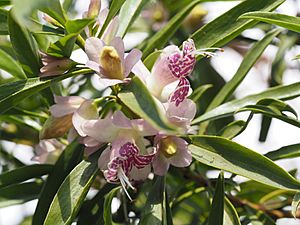Varnish bush facts for kids
Quick facts for kids Varnish bush |
|
|---|---|
 |
|
| Eremophila viscida growing in Kings Park, Perth | |
| Conservation status | |
| Scientific classification | |
| Genus: |
Eremophila (plant)
|
| Species: |
viscida
|
| Synonyms | |
|
|
The Varnish Bush (scientific name: Eremophila viscida) is a special flowering plant found only in Western Australia. It's a large shrub or a small tree that gets its common name because its new leaves are quite sticky, like they've been varnished! This plant is known for its pretty, colorful parts around the flowers and its greenish-white petals with cool red or purple patterns. It belongs to the figwort family.
Contents
What Does it Look Like?
The Varnish Bush can grow to be a shrub or a small tree, reaching a height of about 2 to 6 meters (6 to 20 feet). Its new branches are very sticky because they have a natural sticky substance called resin. These branches are smooth, shiny brown, and feel a bit rough because of old leaf bases that stay on them.
Leaves
The leaves grow one after another along the branches. Each leaf has a short stem, about 4 to 6 millimeters (0.16 to 0.24 inches) long. The leaf blades are shaped like an oval or a spear, getting narrower at both ends. They are often folded into a U or V shape. Most leaves are about 45 to 90 millimeters (1.8 to 3.5 inches) long and 10 to 21 millimeters (0.39 to 0.83 inches) wide. They are smooth and, just like the new branches, they are sticky.
Flowers
Varnish Bush flowers grow either by themselves or in small groups of up to three, right where the leaves meet the stem. They grow on smooth, sticky stalks that are about 5 to 7 millimeters (0.20 to 0.28 inches) long.
Each flower has five overlapping, egg-shaped, smooth, and sticky sepals. Sepals are like small leaves that protect the flower bud. These sepals are about 14 to 20 millimeters (0.55 to 0.79 inches) long and can be yellow with a metallic blue-green shine, or sometimes pinkish-red.
The petals are about 20 to 25 millimeters (0.79 to 0.98 inches) long and are joined together at their base to form a tube. The outside of this petal tube is usually cream-colored with a hint of red or metallic blue-green. Inside the flower, on the petals and tube, you'll see red to blackish-purple spots. These spots can sometimes connect to form lines or larger colored areas. Both the inside and outside of the petal tube are covered with tiny, sticky glandular hairs.
The flower has four stamens (the parts that produce pollen) that stick out beyond the end of the petal tube.
Flowering Time and Fruit
Varnish Bush flowers bloom between September and November. After the flowers, the plant produces fruit. These fruits are dry, woody, and oval-shaped, about 5 to 7.5 millimeters (0.20 to 0.30 inches) long. They are partly covered with simple and glandular hairs.
How it Got its Name
The Varnish Bush was first officially described by a scientist named Stephan Endlicher in 1838. He published his description in a book called Stirpium Australasicarum Herbarii Hugeliani Decades Tres. The second part of its scientific name, viscida, comes from a Latin word that means "sticky." This perfectly describes its sticky leaves and branches!
Where it Grows
The Varnish Bush is found in Western Australia. It likes to grow in granite-rich soils in areas with lots of shrubs, especially near the edges of salt lakes, on sandy plains, and in rocky valleys. You can find it between the towns of Warralakin and Mullewa.
Protecting the Varnish Bush
The Varnish Bush is considered a "Threatened Flora" by the Department of Environment and Conservation in Western Australia. This means it's a very important plant that needs protection.
It is also listed as "Endangered" (EN) under the Australian Government's Environment Protection and Biodiversity Conservation Act 1999 (EPBC Act). This means it's at a high risk of disappearing from the wild. Because of this, a special plan has been made to help it recover. In 2003, scientists knew of 16 different groups of these plants, with a total of 816 mature plants. Efforts are ongoing to protect these remaining plants and help their numbers grow.
Growing Varnish Bush at Home
This large Eremophila plant produces many beautiful flowers in spring, which are very attractive to birds that feed on nectar.
It can be a bit tricky to grow new Varnish Bush plants from cuttings (small pieces of the plant). However, the variety with cream-colored flowers is a bit easier to grow this way. Another method is to graft it onto a Myoporum rootstock. Grafting is like joining a piece of the Varnish Bush onto the roots of another plant to help it grow better.
The Varnish Bush can grow well in many different types of soil, even those that are alkaline (not acidic) or clay-based. It likes to be in full sun or partial shade. Once it's established, it doesn't need much watering, even during long dry periods, though it might lose some leaves. It can also handle frost, which means it's quite a tough plant!


